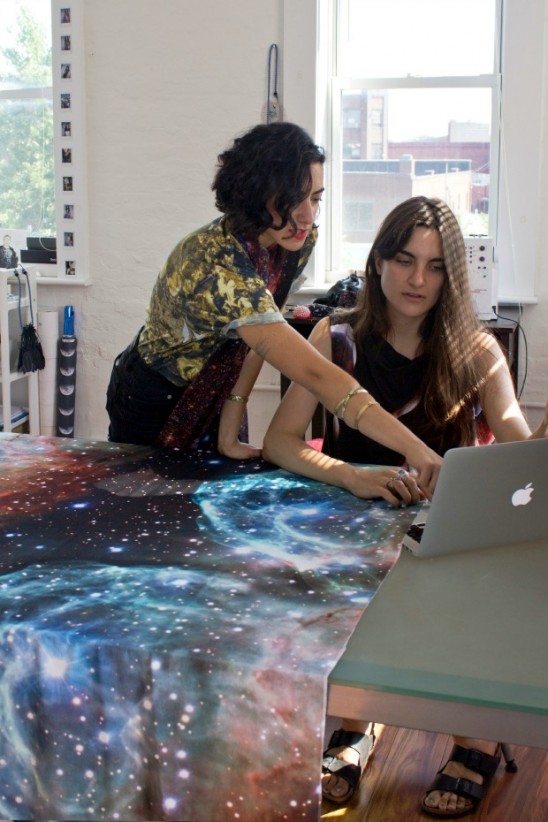As a creator of original designs or handmade products you’ve tackled the most important part of your business, what to sell. Now you find yourself taking on new questions that may be harder to answer. You’re starting to ask, “Where can I sell my handmade items?” and inevitably “How do I sell my designs online?” We’re happy to answer your first question and encourage you to check out our submission page, but before you click that link, take some time to think about whether your product is ready for retail.

Ali Bennaim and Ximena Chouza working on their Cat’s Paw Nebula Lightweight Wool Scarf
With this in mind, let’s talk about the how, as in, how to sell your designs or handmade products online. We brought together a team of experts from Merchandising, Product Development, Purchasing, and Creative backgrounds to give you the low-down on the five most important things you should know before you consider selling or submitting your designs to an online retailer. These tips aren’t specific to our company; you should be taking these steps with every online retailer you might wish to sell or submit your product to. With some strategic planning you’ll be able to turn your passion into profit in no time.
1. Make it easy for buyers to buy into your brand
 Ne’Quana, the associate buyer for our tabletop category, said she’s more likely to partner with an artist after they submit a product through our submissions page if they keep the following guidelines in mind.
Ne’Quana, the associate buyer for our tabletop category, said she’s more likely to partner with an artist after they submit a product through our submissions page if they keep the following guidelines in mind.
- Clearly state the submitted product name and description.
- Include images of the product and its function.
- Describe unique, problem solving, well-crafted, and visually impactful product or packaging.
- Share a website for your product if you have one; if not, it’s nice to note whether you have other products as well.
- Complete the entire submissions form. By providing all the information upfront, you help alleviate most questions our buyers will have in advance.
- Know the difference between the wholesale cost and retail price.
2. Test your materials for performance
 Morgan, our senior production manager, thinks the products we carry should be able to handle everyday use and function. Here are his recommendations for making sure your item is retail ready.
Morgan, our senior production manager, thinks the products we carry should be able to handle everyday use and function. Here are his recommendations for making sure your item is retail ready.
- Test materials for performance. Do your materials perform well for intended use?
- Put yourself in the shoes of a customer and think about how they might use and interact with the product individually as well as what usage over time will do to the product.
- Consider what your product is made of. Are your materials durable? How do your materials interact with one another?
- Think about the design’s lifespan. Will your item last? Nothing lasts forever, but a customer has a right to expect that a product will last.
3. Understand your production capacity
 Rachel is our inventory planning analyst. She forecasts how many units of one product we may need and sell at any given time of the year. Here are her insights on how you can scale your production in time for the holidays.
Rachel is our inventory planning analyst. She forecasts how many units of one product we may need and sell at any given time of the year. Here are her insights on how you can scale your production in time for the holidays.
- Makers, especially makers of handmade products, should have an idea of their production capacity on a weekly and monthly schedule.
- Be sure to keep track of how many items you can produce in a day, a week, and a month.
- Make sure to factor in the time it takes to package a product and bring it to UPS if UPS or a shipper doesn’t come to you.
- The more a vendor can become aware of their limitations and brainstorm ideas to get around them, the better.
- An example: A vendor we work with carries a signature ceramic bowl which they sell to multiple customers. However, they might have a specific glaze/color produced exclusively for UG. A way to cut down on production time would be to fire a large quantity of their signature bowls ahead of time. They can then spend their busiest weeks glazing those bowls and choose which glaze to use depending on which bowl is being ordered. In this way their production output can go up significantly for weeks where they stand to sell more units than they could normally produce in that same period of time.
4. Take high-quality product photos
 Emily, our senior photographer, says the higher the quality of your photos, the better your submission will be. Here are her tricks on how to achieve great shots of your item that will attract any buyer.
Emily, our senior photographer, says the higher the quality of your photos, the better your submission will be. Here are her tricks on how to achieve great shots of your item that will attract any buyer.
- Lighting is the number one most important factor in photographing your product. Here’s a post explaining why lighting is so important: How To Make It:5 Photography Tips
- You don’t need a lot of lights; all you really need is a great sunlit window and a white fill card. A fill card is simply anything you use to reflect light, which allows you to fill with light for darker and shadowy areas in a photograph.
- Fill cards are traditionally white and made of foam core or poster board, but can also be silver or gold depending on the quality of light you want to reflect.
- When picking which window to use, pick one that allows diffused, soft light to shine through. What you don’t want is really harsh sunlight. If the light is too hard, it can make one part of your image too bright in comparison to the rest. Look for a nice, even light.
5. Write clear product descriptions
 As a copywriter, Eric makes sure the stories we tell about our products are compelling and exciting, but also useful. Here are his tips on how to steal our attention with your product description.
As a copywriter, Eric makes sure the stories we tell about our products are compelling and exciting, but also useful. Here are his tips on how to steal our attention with your product description.
- The best product descriptions strike a balance between essential details; what it is, how it’s made, what it’s made of, and how it functions are all questions you should answer in your product copy.
- Add a pitch of potential benefits that make the item unique.
- Make sure your description of an object is not put out of context; a persuasive case for why someone would want or need your product should be explained.
Now that you’re armed with tips on how to make your product retail ready for online retailers, it’s time to hustle and submit your fantastic products!
More maker resources from our blog


No Comments